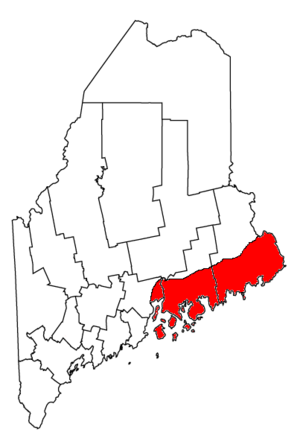Down East facts for kids
Down East (or Downeast) is a special name for parts of the eastern coast of New England in the United States and Canada. It mainly refers to the state of Maine and Canada's Maritime Provinces. This area is much like the old French territory called Acadia.
The name "Down East" comes from sailing. Sailors traveling from western ports would sail downwind (with the wind behind them) to go east. So, they would say they were going "Down East." Someone from this area might be called a "down-easter." In Maine, "Down East" can also mean just the easternmost parts of the state, known as Down East Maine.
In 2022, the Downeast Maine National Heritage Area was created. This special area helps protect important historical and cultural places. It covers Hancock and Washington counties in Maine.
Contents
Where Does "Down East" Come From?
The name "Down East" comes from how sailors talked about directions. It's not about a specific place, but about the direction you sail. During warm months, the wind along the coast of New England and Canada usually blows from the southwest. This means ships going east would sail downwind. So, the areas to the northeast were called "Down East" by sailors from bigger western cities like Boston.
Sailors would also say they were going "up to Boston" when traveling from Down East ports. People in Maine still use this phrase today, even though Boston is south of Maine. The term "Down East" can be used in different ways. The Oxford English Dictionary first found the phrase in print in 1825. The term "down-easter," meaning a person from this area, appeared in print in 1828.
How "Down East" Is Used
The phrase "Down East" is used in several ways. Most broadly, it refers to areas from northeastern New England all the way into Canada's Maritime Provinces. Some people, like Sargent F. Collier, thought Down East stretched from Maine into Canada as far as Chaleur Bay. This large area is similar to the old French colony of Acadia. Collier believed this showed a cultural link to the past.
According to Maine writer John Gould, "Down East" is "a never-never land always east of where you are." The term depends on where you start from. Boston is the traditional starting point for deciding what is "Down East." Sailors going from one port in Maine to another nearby might say they were going "down Maine" or "east'ard." They saved "Down East" for places much farther away.
Down East in Maine
In New England, "Down East" often refers specifically to Maine. It especially means the coastal areas. The phrase is very common in the state. Maine's biggest monthly magazine is even called Down East. Amtrak named its passenger train service between Boston and Brunswick, Maine the Downeaster.
The term "Down East" also gave its name to a famous type of sailing ship. These ships, called Down Easters, were developed in Maine in the late 1800s. They were an improved version of the earlier clipper ships. Down Easters had new designs that let them carry much more cargo. They were mainly used to transport goods like wheat from California to Europe. These ships were typically built in Maine, and their captains often came from the state.
Down Easters were a big part of Maine's sailing history. They were among the last important sailing ships built before steamships took over the industry. Even though steamships became more common, Maine boatbuilders remained popular. They continued to build sailing yachts and motor yachts. Today, many modern boat designs are influenced by Maine's lobster boats and are called 'downeaster' style boats.
In Maine, "Down East" can also mean a smaller, specific area. This is the easternmost part of the state along the Canada–US border. This area is also called "Down East Maine" or "Downeast Maine." It's on the coast, roughly between the Penobscot River and the border. It includes rural Hancock and Washington counties. Towns like Deer Isle, Bar Harbor, Machias, Jonesport, and Eastport are in this region.
This part of Maine was one of the last areas settled by Europeans. The French did not settle much here because of the difficult climate. British colonists arrived only after French control ended in 1763. Early British settlers first tried farming, but soon turned to fishing to survive. Fishing is still a very important part of the economy here. Because of its tough climate and remote location, Down East Maine remained one of the state's least developed areas for a long time. More recently, Down East Maine has become a center for creative businesses. This has also led to some changes in the area, like new people moving in.
Down East in Canada
In Canada, "Down East" usually refers to the Maritime Provinces. These are New Brunswick, Nova Scotia, and Prince Edward Island. Sometimes, Newfoundland and the Gaspé Peninsula in Quebec are also included.
The term gave its name to Down East fiddling. This style of music started in the Maritimes. It has become one of the most famous styles of Canadian fiddling. The style is strongly linked to Don Messer, who was from New Brunswick. He hosted a radio show on Prince Edward Island starting in 1939. He had a big influence on fiddle music across Canada. The Down East fiddling style is known for its simple playing and rhythms that are great for dancing.


